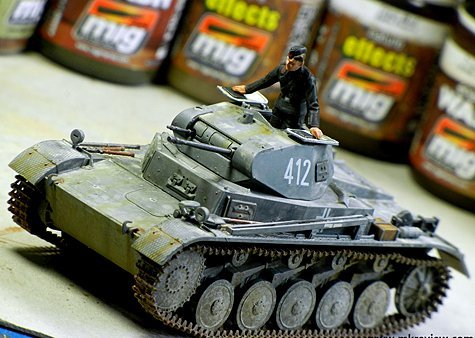
In the mid 1930s, the German military pushed the production of tanks. The Panzer I designed as a training tank, did not have the adequate performance, so a light tank was needed to full the gap until the Panzer III could be introduced. Therefore, the German Ordnance Department issued a request for a new training tank that could be used for combat. In the end, MAN was chosen in 1934 to produce the Panzer II, a compact 4.8m long, 2.2m wide design with a three man crew. The 8.9 ton tank featured a 2cm Kwk 30 L/55 cannon and 7.92mm machine gun in the turret, 15mm armor protection for turret and hull front, leaf spring suspension, and a 140hp Maybach HL 62 TRM engine matched with a ZF SSG46 transmission, which gave it a 40km/h top speed.

The Ausf. A was produced from 1937, followed by the Ausf. B and C, which were difficult to distinguish from each other visually. About 1,100 Panzer tanks were produced by April 1940, and due to delays with the Panzer III, they were immediately issued as the Panzer divisions’ main tank for the invasion of Poland in September 1939.
Based on lessons learned on the battlefields of Poland and, in May 1940, France, improvements such as extra armor and a turret cupola were added, and the Panzer II went on to serve in North Africa and Russia in front line and liaison and reconnaissance duties until the end of 1943. Afterwards, they were used to police occupied territories and the chassis was also adapted for use as the basis for various self-propelled gun designs.
The Kit:
This is the 1/48 Scale German Panzerkampfwagen II Ausf.A/B/C (Sd.Kfz.121) French Campaign Plastic Model Kit from the Tamiya Military Miniature Vehicle Series.
This is another interesting subject in the quarter scale added to my growing collection. A 1/48 Panzer II from Tamiya Models that can be built as either an A, B or C version. Unlike many models from Tamiya in the 1/48th scale, this one lacks the diecast lower hull found on most of their armour model kits of this scale. Obviously the leaf type suspension would have been hard to recreate with such crisp detail in diecast. Instead, the kit includes 2 solid metal tubes to add the weight to the model. This might seem a bit unnecessary to some but it does actually serves its purpose. A 1/48 kit doesn’t have the weight benefit of the larger 1/35 counterpart. Either thru a diescast lower hull or weights, the road wheels and tracks all touch the surface.
- Authentically reproduced
- Detailed armor plates on turret and hull
- Differences between cariants accurately depicted
- Assembly type tracks with one-piece straight sections
- Metal chassis weights
- Commander figure (full body)
- Waterslide decals
- Kit # 32570
- MSRP: $31.00 USD
- Scale 1/48
Decal Options
- 6th Panzer Division, France, 1940
- 35th Panzer Regiment, 4th Panzer Division, France, 1940
- 36th Panzer Regiment, 4th Panzer Division, France, May 1940
The instructions start with the lower hull followed by the tracks. As it is already the norm with these 1/48 kits from Tamiya, they offer the lower and upper tracks in long segments and individual tracks to go around the idler and drive wheels. After a few years building tanks in 1/48 scale, this one was a challenge to me. I use Tamiya Thin Cement for most of my builds but Ambroid Pro Weld Plastic Cement has proven to be the best cement with stronger bond for individual links (IMHO). The individual links on this kit have little surface area in which the plastic cement will do its work. As a result, links will snap here and there. This is in no way a defect on the kit but rather the nature of the links in the real tank. I had to use a hair drier to soften the assembled tracks and bring them to place. They are there and survived the photo session, but I wouldn’t be surprised if in a few weeks or months from now I find a snapped link on the shelf.
If I had to build this kit again, I would move the idler wheel’s prong at least .5 mm to release some of that tension from the tracks. By the way, the links are very crisply molded and due to their delicate nature, caution should be observed when removing them from the sprues. The upper track sections do fall in the right spots over the return rollers to create that nice natural saggy effect on the tracks.
The rest of the build went without a problem. The supplied full body tank commander figure is very usable. The instructions are clear as to which part should be added or omitted to create either version A, B and C. The decals worked very nice with no hint of silvering and responded very well to Solvaset decal solution. The only negative sentiment with this kit is the poor excuse Tamiya provides as an exhaust cover. Nothing more than a decal. The model as whole would have benefited greatly from a photo etched exhaust cover and I’m pretty sure that adding a small piece of photo etched metal wouldn’t increase the cost of this kit for more than a dollar. Other than that, the kit is very nice I highly recommend it.









































